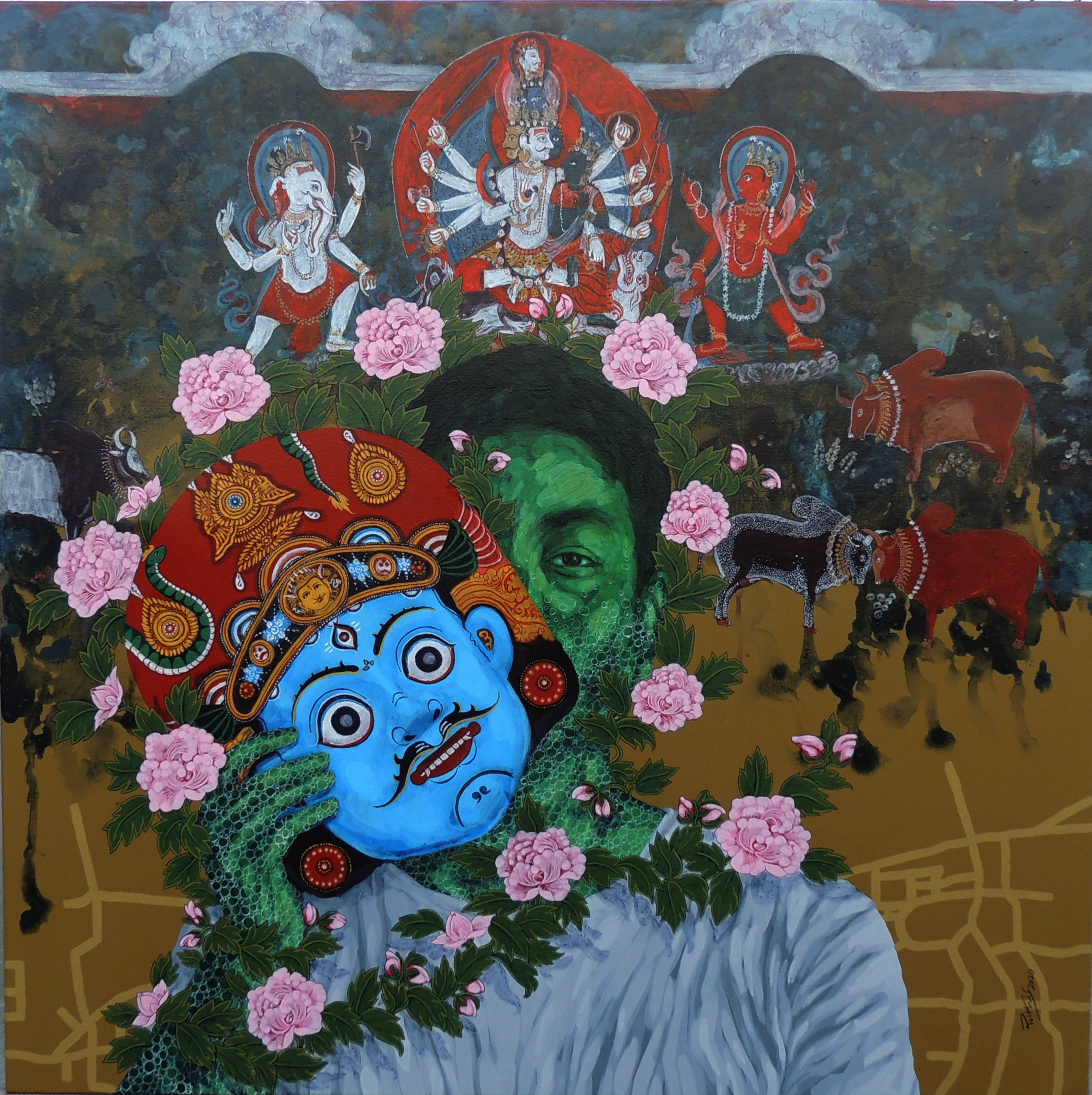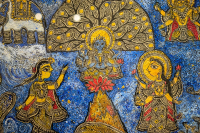Culture & Lifestyle
Reflections on society, culture and resilience
‘Flowing Together’ at Gallery Mcube showcases Saurganga Darshandhari and Prithvi Shrestha’s rendering of familial bonds and societal complexities.
Anish Ghimire
At Gallery Mcube, artists Saurganga Darshandhari and Prithvi Shrestha are collectively showcasing their works. The curator and founder chairman of the gallery, Manish Lal Shrestha, reveals the reason for this in the curatorial note, saying, “For numerous years, Darshandhari and Shrestha have been longstanding art partners, gracefully navigating the complexities of societal discourse while articulating contemporary values in their creations.”
Darshandhari’s expertise in silk screen art is captivating at first glance. Her work documents stories of human connection and resilience. There are two series of paintings in focus here, ‘Maya’ and ‘Returning Home’. Through these two series, Darshandhari invites viewers into a world where emotions flow freely, depicted in intricate segments that unravel the complexities of familial bonds.
Within the ‘Maya’ series, Darshandhari delves deep into the intimate dynamics between spouses and within families. Each neatly crafted segment serves as a chapter in her visual diary. “This is my diary,” she says as she walks me through her painting. In it, she poignantly captures the essence of maternal love and familial unity. As she walked me through her artwork, her brushstrokes were like thread, weaving together stories of tenderness and endurance.
Central to Darshandhari’s thematic exploration is the motif of flowing structures, mirroring the fluidity of life itself. Like water coursing through a river, her paintings remind us that existence is a journey filled with twists and turns. Despite the obstacles encountered along the way, Darshandhari’s message is that “life must be embraced, its currents navigated with grace and resilience.”
“As a woman,” Darshandhari reflects, “we bear the weight of numerous trials, yet within us lies the strength to endure.” Her art reflects the indomitable spirit of womanhood, celebrating the power to persevere despite adversity.
In another series, ‘Returning Home’, she ventures into the realities of contemporary Nepali society, where the departure of youths and the return of stolen national treasures to the country intertwine to paint a vivid portrait of societal flux. Echoing the feelings of a country at a crossroads, Darshandhari tackles the contradiction between the return of cultural legacy and the exodus of youthful promise.
In ‘Returning Home 3’, two paper aeroplanes are the centre of focus, each laden with symbolic weight. The ascending plane carries departing youths clutching Nepali instruments, symbolising not only their physical departure but also the erosion of cultural heritage as they journey abroad. On this, she remarks, “Nepalis aren’t just leaving their homeland; they’re taking our culture with them.”

Conversely, the descending aircraft bears the weight of repatriated Nepali artefacts, symbolising stolen treasures finding their way back to Nepali soil.
In another piece from the same series, a house sits atop one of the aeroplanes. Through this, Darshandhari exposes the harsh reality of Nepali youths selling their properties to finance their journeys overseas, highlighting the sacrifices made in search of security and prosperity.
Through ‘Returning Home’, Darshandhari asks viewers to confront the complexities of migration, identity and sacrifice in contemporary Nepal.
Prithvi Shrestha, specialising in watercolour artistry, weaves together themes of resilience, love and cultural reverence in his diverse portfolio. Like Darshandhari, Shrestha has projected his thoughts into his work. His work feels like a gateway to earnest reflections on the human condition.
In his evocative series ‘Flow’, Shrestha aptly captures the essence of life’s journey. Through vibrant hues, he portrays the undulating rhythms of our lives, reminding us that despite the inevitable ups and downs, the current of life propels us ever forward. “In life, there are ups and downs,” Shrestha says, “but we still keep moving ahead,”
The ‘Couple’ series is infused with whimsy and charm. In this, Shrestha celebrates the timeless bond of love by making insects and birds his subjects. Birds and insects, made with life-like detail, become metaphors for the profound connection shared between soulmates. “Because this is Valentine’s week, this becomes even more relevant,” he explains.
However, it is Shrestha’s ‘Mask’ that seems like the highlight of the exhibit. Using the stories and legends from Nepali mythology, Shrestha paints pictures of gods and goddesses wearing masks. Each mask represents a strong belief in gods and myths in Nepali culture. “Growing up, I heard many stories about gods and how powerful they are,” Shrestha says, adding, “I want to show that belief in my art.”
Shrestha’s art encourages us to explore spirituality and tradition, where the holy and everyday life mix in a beautiful blend of colours and shapes. Each mask he creates represents not just the might of gods but also the strength inside us all. It echoes the wise stories passed down through generations.
In one of his paintings from the ‘Mask’ series, Shrestha features Myna bird that is scarcely seen nowadays. He symbolises this bird as a representation of our gradually fading culture. Standing before the painting, Shrestha reminisces, “I remember seeing this bird everywhere during my childhood, but now, it’s a rare sight. It feels like we’ve forgotten about this bird, just as we're slowly losing touch with our cultural roots.”
He shares that he enjoys incorporating subjects like birds into his artwork because, to him, they symbolise the enduring goodness that still exists in our chaotic world. Through these avian symbols, Shrestha reminds us of the beauty and purity that endure amid the hustle and bustle of modern life.
Additionally, Shrestha subtly integrates city maps of Kathmandu into his paintings. This inclusion suggests that the stories depicted in his artwork are reflections of our immediate surroundings, bridging the gap between the personal and the universal. His work makes the viewer contemplate the interplay between culture, environment and human experience.
Curator Shrestha says, “The works of these two artists celebrate artistic unity, illustrating the enduring influence of collaboration and the balance between life and creativity. Beyond being a mere expression of societal concerns, their art interweaves personal and shared emotions.”





 14.72°C Kathmandu
14.72°C Kathmandu















